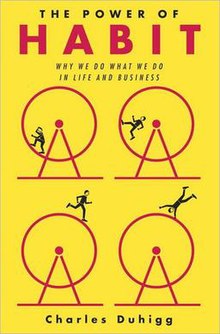2020-1 The Power of Habit: Why We Do What We Do in Life and Business by Charles Duhigg (2012), Random House Trade.

I am reading not only for the content, but to deepen my awareness of the art of writing. This book was on the best seller list for The New York Times, Amazon.com, and USA Today, and won the Financial Times and McKinsey Business Book of the Year Award in 2012. So, I thought it would be good.
It is a book that is very easy to summarize. The points are simple.
- Habit is subconscious. Even if your medial temporal lobe (responsible for cognitive tasks such as short term memory and emotional regulations, P. 7) is destroyed, new habits can be learned and stored in basal ganglia (P. 13-14). According to a study in 2006, 40% of the actions people perform each day were habits (P. xvi). “Habits, scientists say, emerge because the brain is constantly looking for ways to save effort. Left to its own devices, the brain will try to make almost any routine into a habit, because habits allow our minds to ramp down more often.” (P. 17-18)
- Habit is a loop of cue-routine-reward, driven by cravings for the reward. (P. 35)

- “But the reason the discovery of the habit loop is so important is that it reveals a basic truth: When a habit emerges, the brain stops fully participating in decision making.” (P. 20) To live our lives consciously and conscientiously, we need to be aware that habits can impact our days and lives, our thoughts and decision makings. What triggers your habit? What reward are you craving?
- The Golden Rule of Habit Change: Keep the cue and the reward, and change the routine.

- There are “Keystone Habits” = that can start a chain reaction, changing other habits, eventually transforming everything. (P. 100)
What works about this book: It combines stories of real people and organizations, and back up the stories with science and data about brain, human behaviors, psychology, marketing, etc. We like reading stories. Stories make science identifiable, and memorable.
What can improve about this book: It simplifies both the stories and the science, to prove (a possibly oversimplified) points. Although it does not pretend to be a self-help book, I also saw many reviewers criticize the book for not suggesting a clear way to implement the findings that this book introduce.
For me, specifically.
I understand the necessity to subjugate certain mundane daily tasks, such as brushing our teeth, certain routine exercises and chores, to automatic, subconscious habits for efficiency. The question is the balance and degree. We all need to recognize that habits have been used to support fascist regimes, wars, authoritarianism, etc. Education, arguably, is implementation of habits. Cultural biases and resulting actions – for example marginalization and segregation of minorities – can be due to our habits. How much of an individual can we be? How much free-will do we really have?
Musically.
There was an interesting section about marketing songs; what makes a song popular, and “sticky” (songs that listeners never seem to change the radio dial for). “Sticky” songs are not necessarily popular, but fulfill the expectation for that particular genre. (P. 201) “..a preference for things that sound ‘familiar” is a product of our neurology…The areas that process music…are designed to seek out patterns and look for familiarity. Our brains crave familiarity in music because familiarity is how we manage to hear without becoming distracted by all the sound. Listening habits allow us to unconsciously separate important noises from those that can be ignored.” (P. 202-3) So how do you sell an new-sounding song? By sandwiching them between familiar sounding songs! This I can immediately implement in my programming!

The book was a bit too long, a bit too simple, and somewhat repetitious. However, the points were clear (because they were simple), well researched, and the stories were told well.